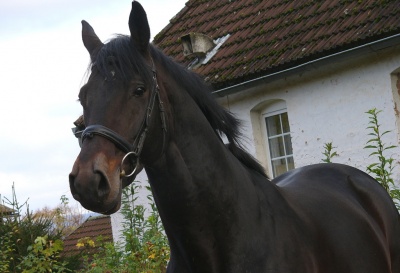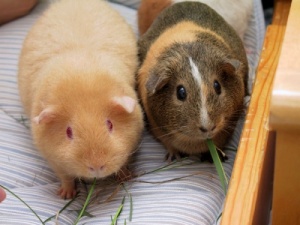George the <a title=”Guinea Pigs” href=”Guinea_Pigs”>guinea pig</a> (2007-August 11, 2009) was a grey American Shorthair who was best known for serving as a turning point in <a title=”Education” href=”Education”>education</a> to <a title=”Veterinarians” href=”Veterinarians”>veterinary</a> hospitals after his death, because the public perceived his story as perfect example of the average animal hospital’s lack of knowledge of guinea pigs and the correct treatment for them.
George lived a happy life until he came down with a fatal bladder stone, a disease that guinea pigs, especially males, are prone to. The common misconception about the maintenance of guinea pigs is that they are “low-maintenance” and “disposable.” This true story proved those stereotypes to be false, and even reached the public through articles, letters, and speeches; “Pet Shoppers, Beware!” (All rights reserved; December 2009; Elizabeth Larsen)
It was decided that Guinea pigs do not make good pets unless veterinarians know how to treat them. If humans cannot properly diagnose these horrendous diseases and care for these sweet creatures without causing them hours of extreme suffering, we shouldn’t expect them to live happy lives as pets under domestication.
George was a step, but it remains to be seen if guinea pig care will improve.
George:
George was approximately a year old when he was put up for <a title=”Adoption” href=”Adoption”>adoption</a> by his previous owner at the Ohio Humane Society, along with a note on his cage reading, “my owner did not want me anymore.” Though the owner’s situation remained unknown, employees and pet patrons sympathized with the unusually adorable guinea pig. George was placed in a room full of cats at the <a title=”Animal Shelters” href=”Animal_Shelters”>shelter</a>.
On October 12, 2008, George was adopted for only five dollars by a family from Dayton, Ohio. (Who wished to remain anonymous in this news story to limit publicity of their names in Google searches).
The family loved George for 10 months; they became more deeply attached to him than they ever had imagined. It has also been said that George captivated the hearts of the whole neighborhood, along with family friends and the hired help, such as the grass cutter and handyman.
George served as more to the family than just a lovable pet. The family’s 11 year-old girl, an animal lover, she claimed that the only way she could be calmed was to “hold George.”
Death:
On the humid night of August 13, 2009, George was squealing/screaming in his cage. George refused to come out of his “hidey-hut” and he hadn’t gone to the bathroom in quite some time. Worried, the mother and kids accompanied him in the landing for hours. Their father was on a business trip, therefore was unaware of what was going on. According to the mother, none of the vets she called that night performed ultrasounds on guinea pigs, except one in West Virginia, which was out of the question.
Their daughter was an “active performer” and had a performance the very next day at a local theater and couldn’t afford to stay up the whole night with George. Reluctantly, she went to bed to prepare for her solo the next day.
At 8 am the next morning, George was rushed to the hospital. He was incorrectly diagnosed because they had no ultrasound machine to be sure, and prescribed a medication. When George was taken home, they attempted to feed him the medicine. George protested vehemently and downed the medicine against his will. Determined to find someone who could confidently diagnose George, the mother called numerous clinics purporting to specialize in guinea pigs and other exotic animals. As it turned out, none of them had the proper equipment to make a proper diagnosis. They suggested that George be taken to Michigan State University in Lansing (1 ½ -hour drive); as an alternative they all offered to “put him down” that very day. Finally she found the Animal Emergency Center of Novi, Michigan, which does have the ability to ultrasound guinea pigs, which is essential in order to make a proper diagnosis. At the hospital, it was revealed that the inflammation was actually an enlarged bladder due to an embedded bladder stone. The vet was optimistic and said that surgery was a possible solution to George’s bladder stone. Hopeful, the mother signed the release form.
Meanwhile, the daughter had to be coaxed on stage, after being very worried about George. She said that she was going to “refuse to sing unless she knew George would be okay.”
Somehow, the word of George’s surgery got to her in time, after her grandmother told the director that George was going under surgery.
Later, the mother received a call from the hospital. The surgery had failed because the stone was embedded, and George, lying unconscious on the operation table, could not be assured of a quality life free of tubes and machines following the surgery. The family made the heartbreaking decision to euthanize George. The father, who had been on a business trip in his hometown of Toronto, Ontario, was also devastated at George’s death, even though he had seemed to put on a “playful persona of disliking George.”
After Death:
In the months following George’s death, the family was questioned about their judgment to invest such a generous amount into George’s surgery.
“He was a guinea pig. Disposable creatures!” Said a neighbor
They simply replied, “We really loved him.”
Unsatisfied with George’s fate and concerned about future suffering in guinea pigs, the family took public action.
Their daughter dedicated a speech to George, exposing the evil <a title=”Industries” href=”Industries”>industry</a> of over breeding animals, featuring a special segment on guinea pigs. Elizabeth delivered “Pet Shoppers, Beware!” on December 12, 2009 in Columbus, Ohio and came out victorious with the statewide 2nd place trophy.
The mother wrote a detailed letter to the hospital that had falsely diagnosed George, along with many helpful ideas that could benefit guinea pigs in the future, even though George was too late.
<!– NewPP limit report Preprocessor visited node count: 1/1000000 Preprocessor generated node count: 4/1000000 Post-expand include size: 0/2097152 bytes Template argument size: 0/2097152 bytes Highest expansion depth: 1/40 Expensive parser function count: 0/100 –>


